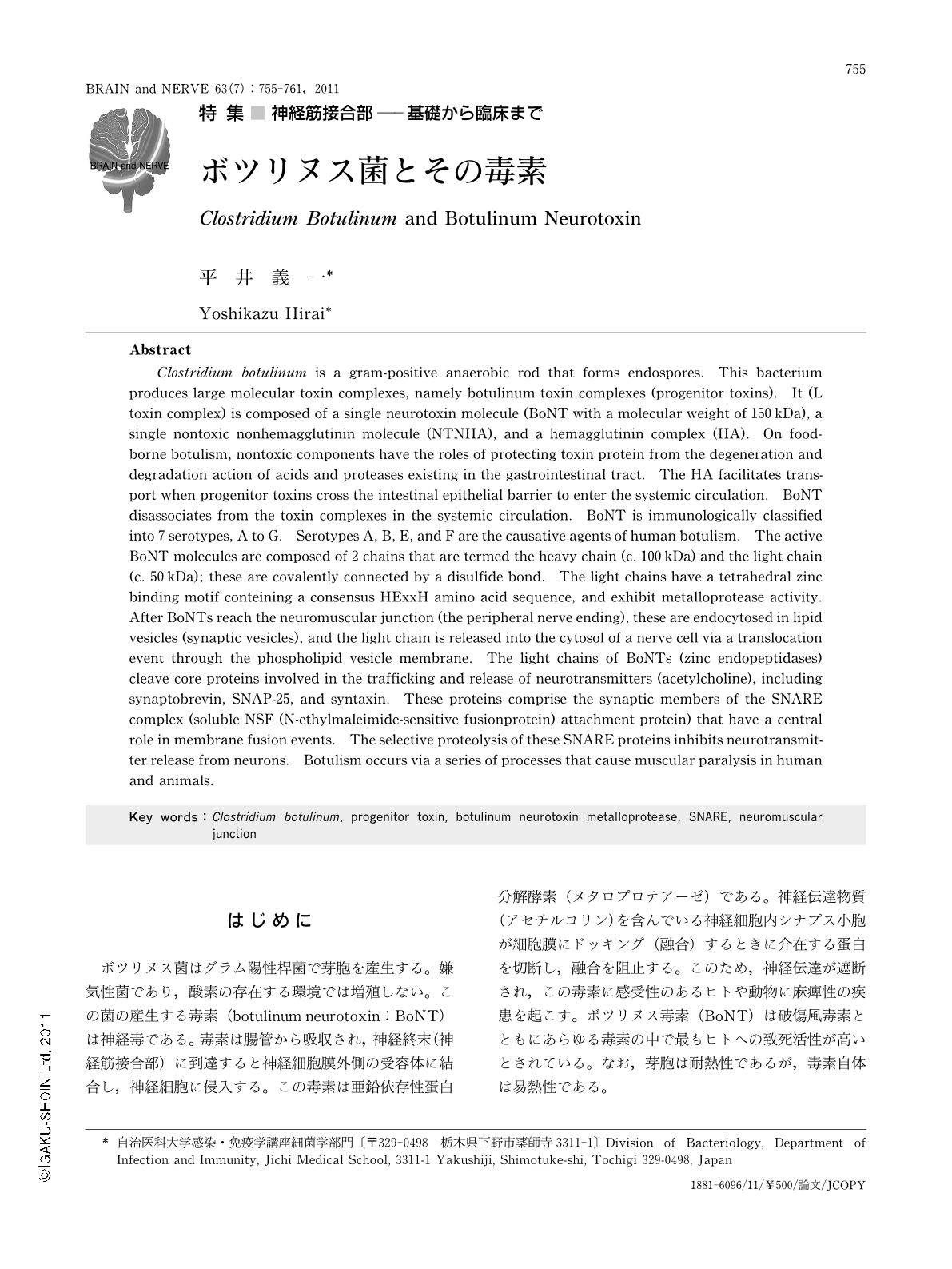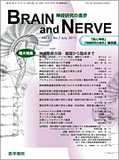Japanese
English
- 有料閲覧
- Abstract 文献概要
- 1ページ目 Look Inside
- 参考文献 Reference
はじめに
ボツリヌス菌はグラム陽性桿菌で芽胞を産生する。嫌気性菌であり,酸素の存在する環境では増殖しない。この菌の産生する毒素(botulinum neurotoxin:BoNT)は神経毒である。毒素は腸管から吸収され,神経終末(神経筋接合部)に到達すると神経細胞膜外側の受容体に結合し,神経細胞に侵入する。この毒素は亜鉛依存性蛋白分解酵素(メタロプロテアーゼ)である。神経伝達物質(アセチルコリン)を含んでいる神経細胞内シナプス小胞が細胞膜にドッキング(融合)するときに介在する蛋白を切断し,融合を阻止する。このため,神経伝達が遮断され,この毒素に感受性のあるヒトや動物に麻痺性の疾患を起こす。ボツリヌス毒素(BoNT)は破傷風毒素とともにあらゆる毒素の中で最もヒトへの致死活性が高いとされている。なお,芽胞は耐熱性であるが,毒素自体は易熱性である。
基本的にBoNTと破傷風毒素は毒素構造や作用機序は同じである。しかし,作用神経や作用状況が異なる。破傷風毒素は神経末端から中枢方向へ運ばれ全身の痙攣性疾患を起こすが,BoNTは神経筋接合部でのみ作用し,神経伝達を遮断する。この遮断で神経細胞そのものは障害されない。この状況から,BoNTは厳密な量調整を行ったうえで,局所的慢性痙性疾患への治療応用が進められている。
Abstract
Clostridium botulinum is a gram-positive anaerobic rod that forms endospores. This bacterium produces large molecular toxin complexes,namely botulinum toxin complexes (progenitor toxins). It (L toxin complex) is composed of a single neurotoxin molecule (BoNT with a molecular weight of 150kDa),a single nontoxic nonhemagglutinin molecule (NTNHA),and a hemagglutinin complex (HA). On food-borne botulism,nontoxic components have the roles of protecting toxin protein from the degeneration and degradation action of acids and proteases existing in the gastrointestinal tract. The HA facilitates transport when progenitor toxins cross the intestinal epithelial barrier to enter the systemic circulation. BoNT disassociates from the toxin complexes in the systemic circulation. BoNT is immunologically classified into 7 serotypes,A to G. Serotypes A,B,E,and F are the causative agents of human botulism. The active BoNT molecules are composed of 2 chains that are termed the heavy chain (c. 100kDa) and the light chain (c. 50kDa); these are covalently connected by a disulfide bond. The light chains have a tetrahedral zinc binding motif conteining a consensus HExxH amino acid sequence,and exhibit metalloprotease activity. After BoNTs reach the neuromuscular junction (the peripheral nerve ending),these are endocytosed in lipid vesicles (synaptic vesicles),and the light chain is released into the cytosol of a nerve cell via a translocation event through the phospholipid vesicle membrane. The light chains of BoNTs (zinc endopeptidases) cleave core proteins involved in the trafficking and release of neurotransmitters (acetylcholine),including synaptobrevin,SNAP-25,and syntaxin. These proteins comprise the synaptic members of the SNARE complex (soluble NSF (N-ethylmaleimide-sensitive fusionprotein) attachment protein) that have a central role in membrane fusion events. The selective proteolysis of these SNARE proteins inhibits neurotransmitter release from neurons. Botulism occurs via a series of processes that cause muscular paralysis in human and animals.

Copyright © 2011, Igaku-Shoin Ltd. All rights reserved.


